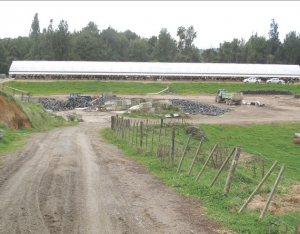“We did our homework as we saw the potential it offered to our farm. And when all Herd Homes users we visited said they increased production by at least 20% because of their Herd Homes it was a factor in us committing to the project,” said Shaun.
They farm at Oropi, 30min south of Tauranga and the farm is 900ha with 430ha for the dairy platform, a 100ha block of native bush, 100ha of plantation pines and the balance a cut-over forestry block. The Herd Home and the dairy shed, a 20-aside herringbone, are at 335m above sea level and the highest paddock is 450m. They trade as Oropi Bushlands Ltd in conjunction with Shaun’s parents Grahm and Joan.
“The contour is steep to hilly, the rainfall is 2000mm, well spread and we do get the odd snowfall,” commented Fiona.
The farm has 35km of races and cows have to walk up to 3.5km to the furthest paddock and the amount of production that walking was costing was another factor in their decision to build a Herd Home.
At present there are 1100 cows on the farm with 450 being winter milked. They are all Friesian and Friesian cross cows. During the season they are milked in three herds of 300 cows each with their own manager being responsible for their herd and area of the farm. They have three vats and three supply numbers so herds can be compared. They supply Open Country Cheese.
“By keeping the herds fewer than 300 there was a lot less damage to our steeper paddocks plus it was ideal for our smaller dairy shed,” said Shaun.
They have not reared any replacements for seven years and all are bought in. “The cost of getting them in calf, some staff were not good at selecting cows, and rearing calves at a busy time of the year made the decision to change easy.”
All replacements are bought in the autumn and are generally empty cows, still milking and with high BW and PW. “Before we buy we can see them as milkers and can check for details such as four teats, age, condition and the bonus of not having to train them for the milking shed.”
They use Hereford bulls, having up to 45 on the farm at any one time and have 85% of the main herd calving in three weeks. There is a demand for the calves but even with a premium they are now using Jersey bulls.
“Both of us are getting a little older, the cows will be easier to calve and smaller animals to handle,” commented Fiona.
They buy in about 40 big bales of grass silage from Ohakune, 650t of locally grown grass silage and 200t/DM of maize silage. It is the intention now they have a better feeding system to increase the use of PKE. Six hundred tonnes of fertiliser are spread annually “and we are not big users of nitrogen.”
Their fertiliser programme is planned with Brian Thomas of Nutri-Link.
They have two parallel Herd Homes each 90m long x 12.5m wide with feed strips on each side of both sheds. In the middle and length of each shed there is a mounded base of pumice/sand mix from the farm, with stalls and railings. Each shed can feed 300 or sleep 250 for 12 hours or house 200 for 24 hours.
The slatted floors are over effluent holding pits 1.5m deep and reckoned to last 12 months before cleaning.
There are two separate pits on each side.
Shaun has installed a perforated downpipe in each pit that allows the urine to drain out and this is pumped to the dairy shed ponds and irrigated to the farm. He believes that at present about 2000L are separated daily and if cows are brought in wet their body hair retains up to 10L per cow.
When the pits are cleaned the effluent will be spread on paddocks furthest from the shed where there has been fertility transfer over the years with the balance to be spread on the forestry conversion block.
Initial results have pleased Shaun and Fiona. They have 450 cows in two herds supplying winter milk with each spending 12 hours in the shed
The first day the cows used the shed there was a dip in production but since then there has been a steady increase of 200-500L per skip-a-day collection.
The cows are now fully fed, eating fewer supplements than last year as all feed is consumed and there is no wastage.
“We are on a 60 day round and we have grass to burn and spending only one hour per day feeding out compared to six hours daily under the old method and getting by with two staff instead of the usual four.”
Other initial benefits include a dramatic drop in tractor usage leading to fuel savings reckoned about $2000 monthly, the races are clean with no tractor usage, half the cow traffic and no muddy paddocks.
A long term aim is to recover the rain water from the roof and recycle it as drinking water for the stock and for wash down water for the dairy shed.
Tel. 021 706 848
www.herdhomes.co.nz
















